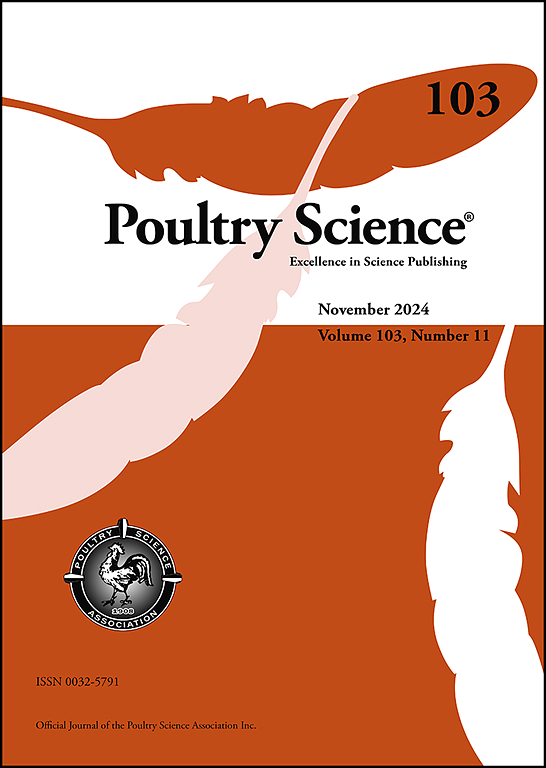Interactive effects of dietary grain and supplemental fat sources on growth performance and carcass characteristics of broiler chickens
IF 3.8
1区 农林科学
Q1 AGRICULTURE, DAIRY & ANIMAL SCIENCE
引用次数: 0
Abstract
The current study investigated if grain type or supplemental fat sources affect or interact for growth performance and nutrients digestibility in broiler chickens offered starter and grower diets with lower metabolizable energy (ME) than breeder recommendations. The experiment was conducted using a completely randomized design with a 3 × 3 factorial arrangement of treatments with three grains (wheat, sorghum, barley) and three fat sources (canola oil, poultry fat, and beef tallow), resulting in nine treatments, each replicated eight times with 25 birds per replicate. Diets were fed in starter (0-10 days), grower (10-22 days), finisher (22-35 days), and withdrawal (35-42 days) phases. Starter and grower diets were formulated to 2875 and 2975 kcal/kg ME, 100 and 75 kcal/kg lower than breeder recommendations. Nutrient digestibility was assessed on day 33, and carcass characteristics were evaluated on day 42 of the trial. There was no significant effect of grain or fat source on body weight gain and feed conversion ratio (FCR) over the starter and grower phases (P > 0.05). There were no interactions of feed grain and fat sources on overall growth performance and age to 2.5 kg body weight (P > 0.05). As the main effect, sorghum-based diets significantly increased overall FCR (0-42 days) compared to wheat- and barley-based diets (P < 0.05). Regardless of fat source, barley-based diets decreased breast meat yield and increased fat pad deposition (P < 0.05). Sorghum-based diets resulted in the lowest ileal starch digestibility (P < 0.05). An interaction between grain and fat source (P < 0.01) showed that poultry fat and beef tallow in wheat-based diets improved crude protein digestibility compared to sorghum- and barley-based diets. In summary, these results indicate that all three grain and fat sources tested in this study can be incorporated into broiler chicken diets without significantly impacting growth rate. However, sorghum-based diets, irrespective of the supplemental fat source, result in lower starch digestibility and approximately a 2-point increase in feed conversion.
求助全文
约1分钟内获得全文
求助全文
来源期刊

Poultry Science
农林科学-奶制品与动物科学
CiteScore
7.60
自引率
15.90%
发文量
0
审稿时长
94 days
期刊介绍:
First self-published in 1921, Poultry Science is an internationally renowned monthly journal, known as the authoritative source for a broad range of poultry information and high-caliber research. The journal plays a pivotal role in the dissemination of preeminent poultry-related knowledge across all disciplines. As of January 2020, Poultry Science will become an Open Access journal with no subscription charges, meaning authors who publish here can make their research immediately, permanently, and freely accessible worldwide while retaining copyright to their work. Papers submitted for publication after October 1, 2019 will be published as Open Access papers.
An international journal, Poultry Science publishes original papers, research notes, symposium papers, and reviews of basic science as applied to poultry. This authoritative source of poultry information is consistently ranked by ISI Impact Factor as one of the top 10 agriculture, dairy and animal science journals to deliver high-caliber research. Currently it is the highest-ranked (by Impact Factor and Eigenfactor) journal dedicated to publishing poultry research. Subject areas include breeding, genetics, education, production, management, environment, health, behavior, welfare, immunology, molecular biology, metabolism, nutrition, physiology, reproduction, processing, and products.
 求助内容:
求助内容: 应助结果提醒方式:
应助结果提醒方式:


